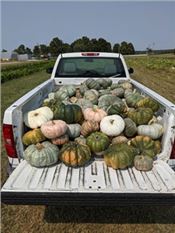Arkansas Grows 10 Edible, Ornamental Pumpkins As Part Of 11-State Squash Hunger Trial

As part of the 11-state Squash Hunger Trial, all 10 varieties of pumpkins grown at the Center for Arkansas Farms and Food in Fayetteville were successful and showed promise as a commercially viable crop.
UA System Division of Ag photo by Matt Bertucci
FAYETTEVILLE, ARK.
A plethora of pumpkins at the Milo J. Shult Agricultural Research and Extension Center is part of the 11-state Squash Hunger Trial.
The Center for Arkansas Farms and Food, a service center of the Arkansas Agricultural Experiment Station, the research arm of the University of Arkansas System Division of Agriculture, grew 10 varieties of edible, ornamental pumpkins as part of the project, said Matt Bertucci, assistant professor of sustainable fruit and vegetable production.
Bertucci coordinated Arkansas’ participation in the study with Annette Wszelaki, lead investigator behind the Squash Hunger Trial and vegetable extension specialist at the University of Tennessee in Knoxville.
The idea behind the Squash Hunger Trial is to look at crops with a long storage life that could supply those without access to fresh vegetables during the fall and winter with nutrient-dense foods for a longer time throughout the year, Wszelaki said. The project includes university partners in Alabama, Indiana, Kentucky, Louisiana, Minnesota, North Carolina, South Carolina, Tennessee, Utah and Virginia.
The varieties grown in the multi-state trial included Blue Delight, Fairytale, Flat White Boer, Jarrahdale, Marina di Chioggia, Mint Prince, Porcelain Doll, Royal Blue, Speckled Hound and Triamble.
“They are all specialty pumpkins of some sort, so they are really attractive on the exterior,” Bertucci said. “They have cool rind patterns, cool textures, but they are all edible.”
The pumpkins range in hues of blue, green, mint, pink, green and orange, with various sizes, shapes and textures. According to an Arkansas extension fact sheet about gardening pumpkins (https://bit.ly/uaex-pumpkin-gardening), pumpkins are among the cucurbit family of flowering plants that include cucumbers, gourds, melons and squashes.
The pumpkin patch was the first mid-scale farm project at the Center for Arkansas Farms and Food, said CAFF farm manager and field educator Jonathan McArthur. Growing pumpkins requires more land per plant than other fruits. About 25-30 square feet are needed per pumpkin vine.
There were six plants per plot at 3-foot spacing on 10-foot centers to make each 180-square-foot plot. Four plots of each variety were planted from transplants in ground that followed a mixed-legume cover crop with general nutrient guidelines of nitrogen, phosphorus, and potassium, McArthur said. The seedlings were transplanted in June and harvested in September. Pumpkins can be harvested 100 to 120 days after planting, depending on the variety.
Heather Friedrich, assistant director of CAFF, said from a production standpoint, the trial was important to find out how each variety did on resisting insects and diseases.
McArthur also noted he has seen a demand for these edible pumpkins as food and not just ornaments.
Wszelaki said the idea behind the Squash Hunger Trial is to look at crops with a long storage life that could supply those without access to fresh vegetables during the fall and winter with nutrient-dense foods for a longer time throughout the year.
In 2020, university partners evaluated 10 varieties of kabocha squash in eight states to find which ones were more tolerant to diseases and pests, Wszelaki said. Kabocha squash, a small Japanese pumpkin, has grown in popularity over recent years but some varieties have been prone to fusarium, a genus of fungus that causes several diseases.
This year, the Squash Hunger Trial was expanded to test “stacker pumpkins” that can provide squash for many meals from one fruit, Wszelaki said. Several of these, like the variety Jarrahdale, are known for their sweet flesh and long storage life.
Summary data from Arkansas test plots
Bertucci said all 10 varieties were “successful” in the Center for Arkansas Farms and Food test plots.
“Any of these pumpkins would produce a commercially viable crop in our growing conditions,” Bertucci said. “This is good news because growers may decide to include one or several varieties in their production, and they should be confident they will see a viable crop.”
Speckled Hound, the smallest variety in the study, offered the most fruit count per plot with an average of 28.25 pumpkins weighing an average of 4.175 pounds. The Speckled Hound vines put out one of the highest tons-per-acre averages. The four-plot total was calculated to provide an expected 14.17 tons per acre, Bertucci said.
Blue Delight pumpkins were the largest pumpkin variety grown in the study. Fruit weights averaged 14 to 16 pounds. Blue Delight was calculated to offer 19.55 tons per acre based on the four-plot count average.
Fairytale, a French heirloom pumpkin with a Cinderella-carriage shape, ranged in weight from 13 to 17.5 pounds in the study. Fairytale and Porcelain Doll came in a tie for second in weight yields. Based on the count from the four plots grown at the center, both Fairytale and Porcelain Doll offered 15.4 tons per acre.
Marina di Chioggia and Triamble had the lowest yield numbers with an expected count of about 9.4 and 8.1 tons per acre, respectively, based on the averages in the four plots, Bertucci said.
The data collected from the Arkansas pumpkin harvest will be sent to the Squash Hunger Trial coordinator, Wszelaki, and consolidated with the different sites. Once all the information is collected, the researchers will be able to make regional recommendations on which crops would be best suited to production in different geographic areas, Bertucci explained.
“We have some state-specific recommendations that would be generated by each researcher but also a broader regional recommendation about which varieties are best adapted for production in these locations,” Bertucci said. Friedrich said the pumpkins are “multifunctional” since they can be kept on the front porch for a while as fall decorations, but they are “also good to eat.”
“They’re all just really beautiful and I like seeing the varieties altogether,” Friedrich said. ∆